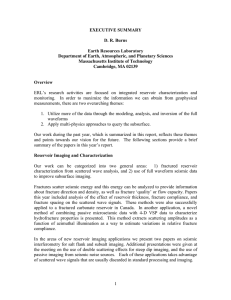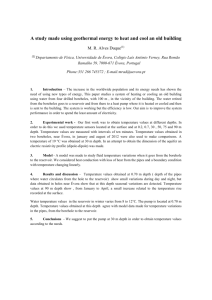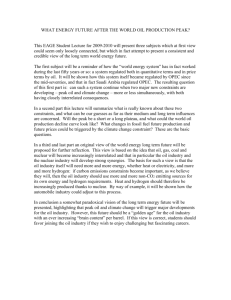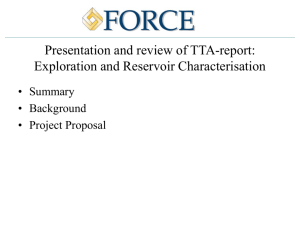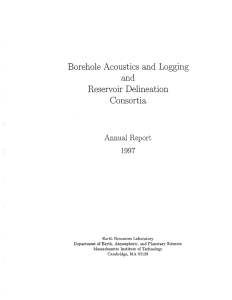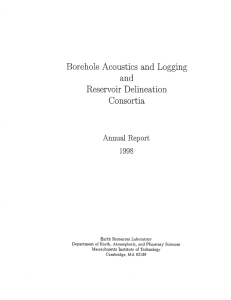Executive Summary
advertisement
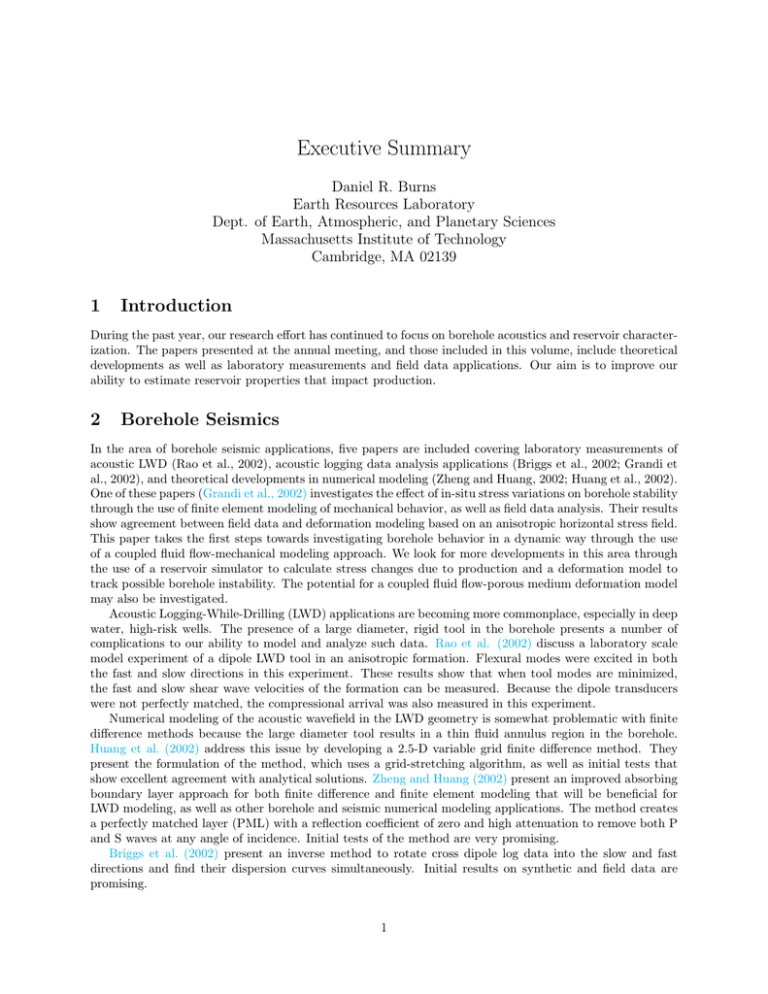
Executive Summary Daniel R. Burns Earth Resources Laboratory Dept. of Earth, Atmospheric, and Planetary Sciences Massachusetts Institute of Technology Cambridge, MA 02139 1 Introduction During the past year, our research effort has continued to focus on borehole acoustics and reservoir characterization. The papers presented at the annual meeting, and those included in this volume, include theoretical developments as well as laboratory measurements and field data applications. Our aim is to improve our ability to estimate reservoir properties that impact production. 2 Borehole Seismics In the area of borehole seismic applications, five papers are included covering laboratory measurements of acoustic LWD (Rao et al., 2002), acoustic logging data analysis applications (Briggs et al., 2002; Grandi et al., 2002), and theoretical developments in numerical modeling (Zheng and Huang, 2002; Huang et al., 2002). One of these papers (Grandi et al., 2002) investigates the effect of in-situ stress variations on borehole stability through the use of finite element modeling of mechanical behavior, as well as field data analysis. Their results show agreement between field data and deformation modeling based on an anisotropic horizontal stress field. This paper takes the first steps towards investigating borehole behavior in a dynamic way through the use of a coupled fluid flow-mechanical modeling approach. We look for more developments in this area through the use of a reservoir simulator to calculate stress changes due to production and a deformation model to track possible borehole instability. The potential for a coupled fluid flow-porous medium deformation model may also be investigated. Acoustic Logging-While-Drilling (LWD) applications are becoming more commonplace, especially in deep water, high-risk wells. The presence of a large diameter, rigid tool in the borehole presents a number of complications to our ability to model and analyze such data. Rao et al. (2002) discuss a laboratory scale model experiment of a dipole LWD tool in an anisotropic formation. Flexural modes were excited in both the fast and slow directions in this experiment. These results show that when tool modes are minimized, the fast and slow shear wave velocities of the formation can be measured. Because the dipole transducers were not perfectly matched, the compressional arrival was also measured in this experiment. Numerical modeling of the acoustic wavefield in the LWD geometry is somewhat problematic with finite difference methods because the large diameter tool results in a thin fluid annulus region in the borehole. Huang et al. (2002) address this issue by developing a 2.5-D variable grid finite difference method. They present the formulation of the method, which uses a grid-stretching algorithm, as well as initial tests that show excellent agreement with analytical solutions. Zheng and Huang (2002) present an improved absorbing boundary layer approach for both finite difference and finite element modeling that will be beneficial for LWD modeling, as well as other borehole and seismic numerical modeling applications. The method creates a perfectly matched layer (PML) with a reflection coefficient of zero and high attenuation to remove both P and S waves at any angle of incidence. Initial tests of the method are very promising. Briggs et al. (2002) present an inverse method to rotate cross dipole log data into the slow and fast directions and find their dispersion curves simultaneously. Initial results on synthetic and field data are promising. 1 3 Reservoir Characterization and Dynamics In the area of reservoir characterization six papers were prepared and presented, four of which are included in this report. Al-Dajani and Toksöz (2002) develop an analytic expression for non-hyperbolic reflection moveout in orthorhombic media with horizontal interfaces. They also find that the azimuthally-dependent stacking velocity and quartic moveout coefficient can be calculated with good accuracy using Dix-type averaging for VTI media, which allows them to extend the non-hyperbolic moveout equation to more general horizontally stratified anisotropic media. Kane et al. (2002a) present a joint inverse method for deconvolution and geostatistical interpolation of seismic data, which effectively allows well data to improve deconvolution and seismic data to improve interpolation of well log data to the interwell region simultaneously. They apply the method to 2-D and 3-D field data sets with good results. Al-Moqbel et al. (oral presentation) used the same 3-D data set and identified seismic attributes (amplitude, phase, frequency, and impedance) that could be used to predict the spatial porosity distribution in a portion of the Ghawar Field in Saudi Arabia. Results were compared to log data from 21 wells, and to well productivity. Kane et al. (2002b) and Herrmann and de Hoop (2002) introduce fractional spline wavelets to seismic analysis applications. Kane et al. (2002b) use this family of wavelets as a basis for the inversion of travel time data for slowness estimation. They show that this wavelet-based method outperforms traditional leastsquares methods of solution. Herrmann and de Hoop (2002) develop a matching pursuit technique for tracking variations in seismic reflections (singularities) through a data volume and relating those variations to geologic transitions. Their method uses multifractional splines to define a dictionary of seismic waveforms parameterized by the localized scale, order, and direction of the singularity. They apply the method to seismic field data and show the value of the approach in both the analysis of interfaces and data de-noising. Finally, Sze and Toksoz (oral presentation) illustrated the use of induced seismicity in a producing reservoir for imaging of subsurface fault planes. They showed that by using a more accurate event location method (double difference relative event location), fault planes could be imaged with improved resolution. This is a developing area for the Lab, and we expected more results involving the monitoring of reservoir dynamics with passive seismic methods. 4 Electroseismic and Fluid Flow The estimation of fluid flow parameters continues to be an important research direction for the Lab. In this report we include four papers in this area. Three of these are in the area of seismoelectric/electroseismic methods, and one involves modeling and visualization of fluid flow in fractured media. Zhu and Toksöz (2002) present results from a laboratory study of seismoelectric conversion in fluid-filled fractures in a cross well geometry. They show that an electrical signal is created when a seismic pulse generated in a borehole interacts with an isolated fracture in a reservoir. They also show that this electrical signal can be measured in a second borehole at some distance from the fracture. This result suggests that it may be feasible to use such a method to detect and characterize permeable structures in the interwell region of a reservoir. Much additional work remains to be done to quantify this effect. Reppert and Morgan (2002) and Reppert et al. (2001) investigate the frequency dependent behavior of the electrokinetic conversion coefficient in a controlled laboratory setting. They look at both the seismoelectric effect as well as the electroseismic effect. Their results are in good agreement with existing theoretical models, and suggest that it may be possible to estimate permeability from frequency dependent measurements in the field. Sarkar et al. (2002) present results of a numerical modeling study of fluid flow in fractured media. The visualization of the flow velocity field in a variety of fracture geometries in 2-D provides insight into the effect of variations in fracture aperture and geometry on fluid flow. These methods will be extended to 3-D and used to develop methods for incorporating fractures into reservoir simulators. 2 5 Future Directions In the coming year we will focus our research efforts in the following areas: 1) borehole seismics, 2) electroseismic methods, 3) reservoir characterization, and 4) reservoir dynamics. In the borehole seismics area we will continue to work on acoustic LWD applications, anisotropy and stress estimation from cross dipole logs, borehole stability modeling, and also move back into some borehole imaging applications, such as single well imaging, reverse VSP, and seismic-while-drilling. In the area of electroseismic and electrical methods, we will continue our efforts on the basic laboratory experiments necessary to develop a method for the estimation of permeability from seismoelectric/electroseismic measurements. Electrical imaging methods will also be explored. Reservoir characterization research will focus on fractured reservoirs and methods for incorporating seismically derived fracture information into reservoir simulators. We will also continue to investigate reservoir heterogeneity estimation from seismic data in a more general sense. Finally, in the area of reservoir dynamics, we plan to investigate ways of using induced seismicity in producing reservoirs for subsurface imaging and in-situ stress monitoring. We will also begin efforts on coupling fluid flow modeling with geomechanical modeling of reservoirs. 3
